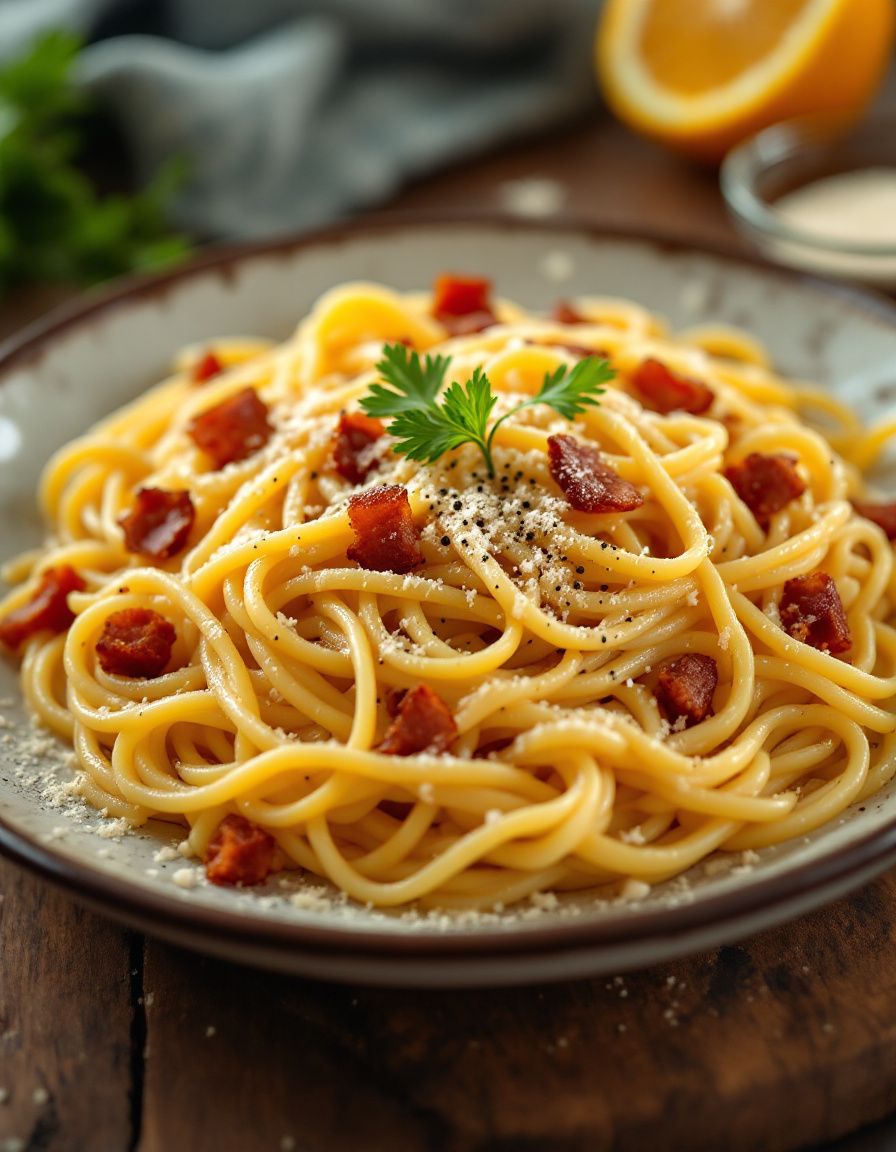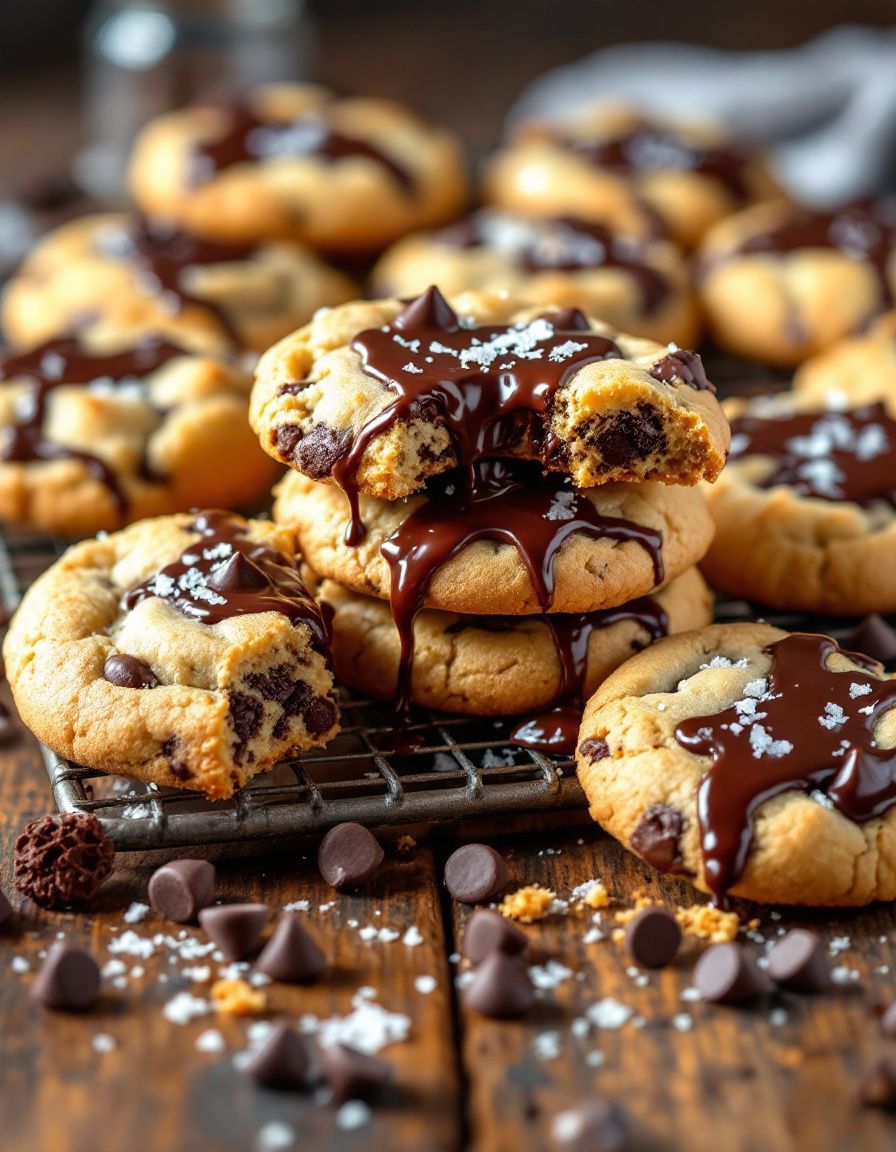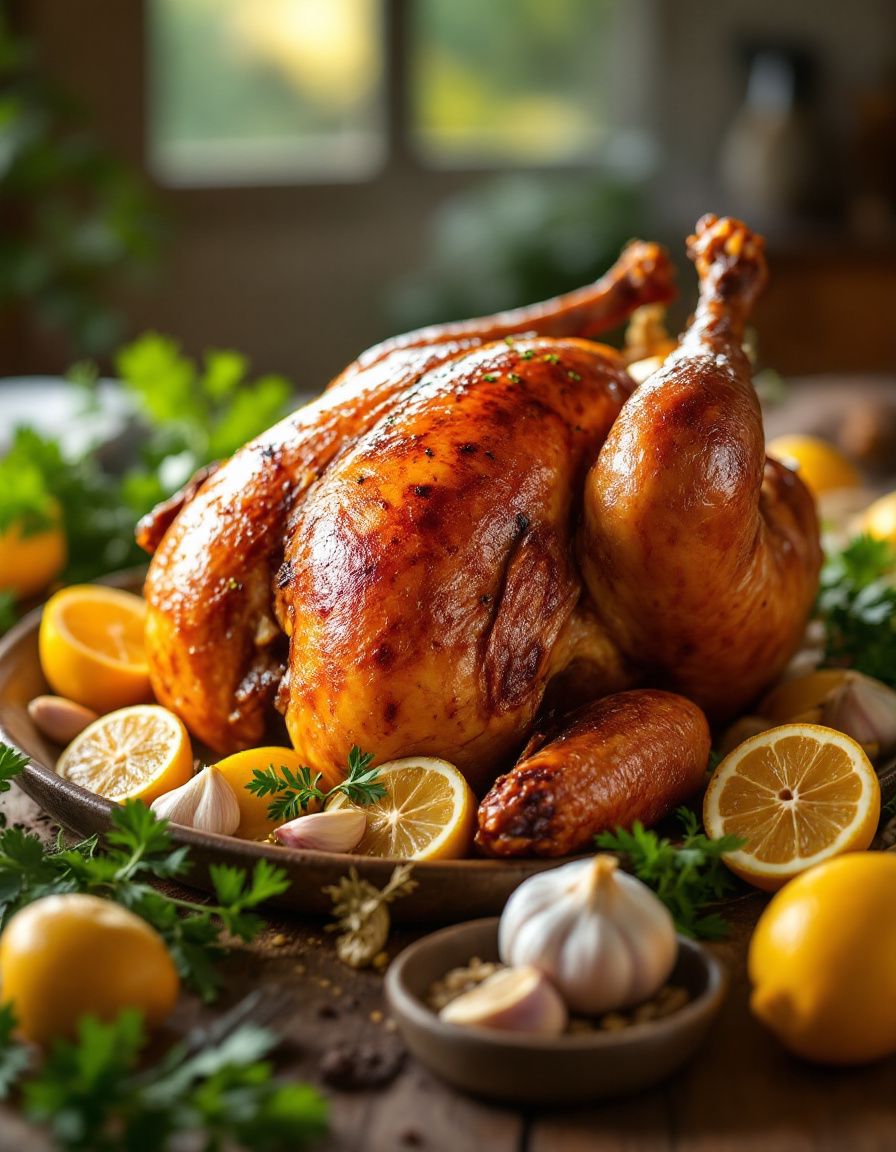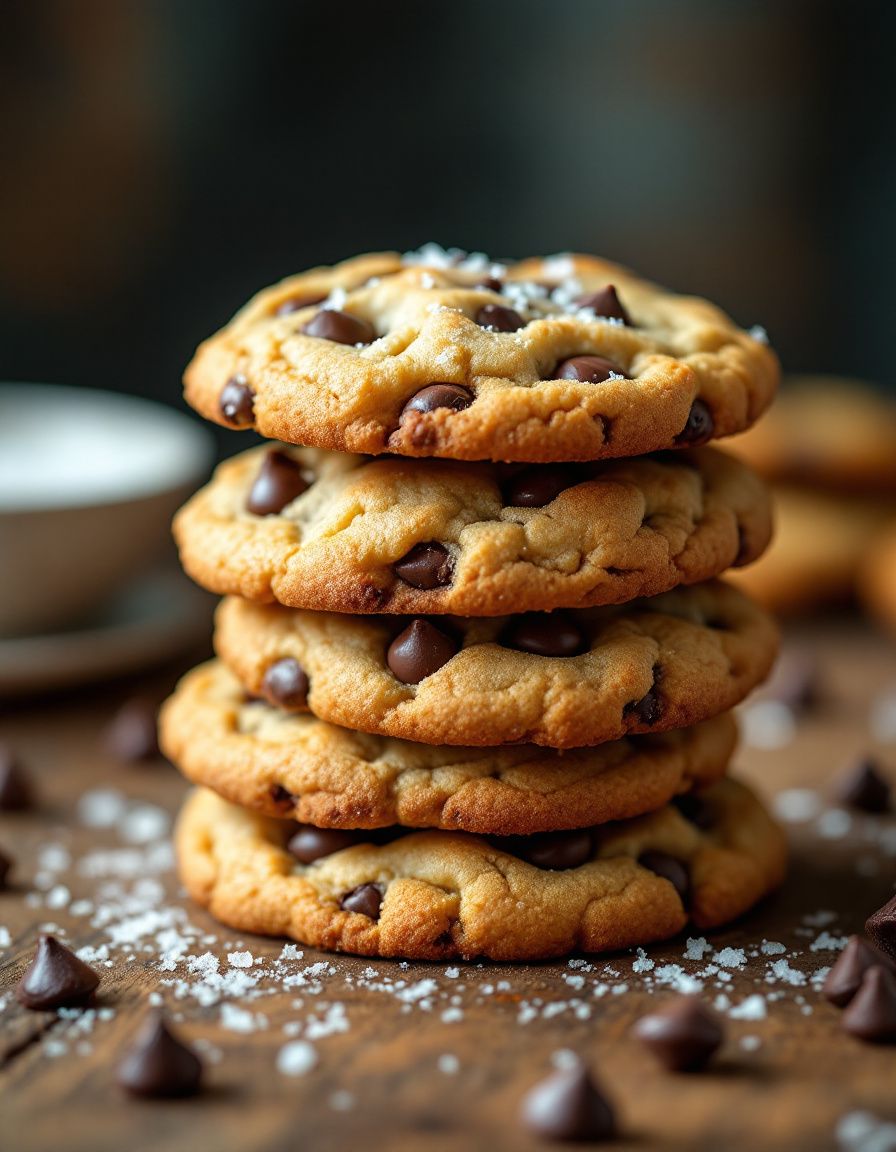Spaghetti Carbonara: A Classic Italian Delight
Spaghetti Carbonara is a traditional Italian pasta dish that captivates with its rich flavors and comforting textures. The combination of al dente spaghetti, creamy sauce, and savory pancetta creates a symphony of taste that leaves food lovers wanting more. This recipe is not only simple to prepare but also offers an authentic taste of Italy that you can recreate in your kitchen. Ideal for both busy weeknights and leisurely weekends, this carbonara is sure to become a family favorite.
The beauty of this Spaghetti Carbonara lies in its minimal yet high-quality ingredients. As the pasta cooks, the heat transforms the eggs and cheese into a silky sauce that clings to each strand of spaghetti, creating a luscious mouthfeel that is irresistible. When you take a bite, you’ll not only taste the creamy richness but also the delightful crunch of pancetta, complementing the dish perfectly. It’s a meal where simple ingredients achieve splendid results!
Quick Recipe Highlights
- Flavor Profile: The blend of salty pancetta and nutty Parmesan gives this carbonara its distinct taste, while the fresh black pepper adds a welcome kick.
- Texture: Enjoy the creaminess of the sauce paired with the firm bite of the pasta, creating a dynamic yet satisfying texture.
- Aroma: The buttery fragrance of sautéed pancetta combined with freshly cracked black pepper fills your kitchen with mouthwatering notes.
- Visual Appeal: The dish presents beautifully with its golden hue, inviting parmesan, and black pepper accents, making it a feast for the eyes.
- Skill Level Needed: With just a few straightforward steps, this dish is perfect for both novice and experienced cooks aiming to impress.
- Special Equipment: A large pot for boiling pasta and a mixing bowl for the sauce are all you need to whip up this delight.
Recipe Overview
- Difficulty Level: This dish is classified as medium difficulty due to the coordination required for timing and ingredient preparation, but with practice, it’s easy to master.
- Category: Spaghetti Carbonara is a classic pasta dish often served as a main course, making it an excellent choice for both everyday dinners and special occasions.
- Cuisine: Hailing from Rome, this traditional Italian recipe showcases the beauty of Italian culinary heritage using simple, quality ingredients.
- Cost: The ingredients are relatively affordable, making this dish a cost-effective option for a delicious meal.
- Season: While delicious year-round, many enjoy carbonara during colder months, as it warms the heart and soul.
- Occasion: Perfect for family dinners, date nights, or even casual gatherings with friends, this dish is versatile for any occasion.
Why You’ll Love This Recipe
The Taste and Texture Appeal: The creamy sauce of Spaghetti Carbonara envelops each strand of pasta, offering a rich mouthfeel that balances perfectly with the crispy pancetta. When you bite into it, the combination of flavors – from the salty meat to the nutty cheese – creates an irresistible dish that tantalizes your taste buds.
Convenience and Preparation Benefits: Preparing Spaghetti Carbonara is quick and easy, taking only about 35 minutes from start to finish. With minimal prep and cooking time, it is perfect for busy nights when you want something delicious without spending hours in the kitchen.
Nutritional Advantages: While Spaghetti Carbonara is indulgent, it does offer nutritional benefits as well. The inclusion of eggs provides protein, while the spaghetti can be made with whole grains for added fiber, making it a well-rounded dish when served with a light salad.
Social and Entertaining Value: Carbonara is a crowd-pleaser! Its comforting familiarity makes it a fantastic choice for entertaining guests or family gatherings, where everyone can enjoy a hearty meal together while creating wonderful memories.
Cost-effectiveness and Accessibility: Most ingredients for this carbonara are easily available at your local grocery store, and the overall cost is budget-friendly. This dish allows you to enjoy a restaurant-quality pasta experience without breaking the bank.
Historical Background and Cultural Significance
Origin Story: Spaghetti Carbonara originated in the Lazio region of Italy, particularly Rome. It is rumored to have been created by Italian coal miners (“carbonari”) who needed a hearty meal to fuel their hard work. The dish has evolved over the years but remains a staple of Roman cuisine.
Cultural Importance: This iconic dish represents the culinary tradition of Italy, showcasing the use of local ingredients and simplicity. Carbonara is often referred to as a comfort meal for many Italians and is served in homes and trattorias alike.
Evolution of the Recipe: The original recipe is thought to have included only a few key ingredients: pasta, guanciale, eggs, and cheese. However, variations have emerged globally, sometimes substituting ingredients like bacon in place of guanciale, which has led to diverse interpretations of the classic dish.
Regional Variations: Across Italy, you may find different takes on carbonara, including variations that add ingredients such as peas or various herbs. However, the traditional Roman style emphasizes the purity and balance of its simple components, remaining a testament to Italian culinary philosophy.
Ingredient Deep Dive
Pasta: The star of Spaghetti Carbonara is undoubtedly the pasta. Traditionally, spaghetti or rigatoni is used for its ability to hold the sauce well. Whole grain or gluten-free varieties can be utilized to cater to various dietary preferences.
For the best results, choose high-quality durum wheat pasta, and cook until perfectly al dente for that perfect bite. Store any leftover pasta in an airtight container in the refrigerator, and try not to overcook it in the boiling water.
Pancetta: Pancetta is a cured pork belly that adds savory depth and richness to the dish. When cooked, it becomes wonderfully crispy, offering both texture and flavor that complements the creaminess of the sauce.
Select a high-quality pancetta, preferably unsmoked, and be sure to keep it in the fridge. For those who don’t consume pork, turkey bacon can serve as a suitable substitute, offering a lighter option while still delivering flavor.
Common Mistakes to Avoid
- Overcooking the pasta: This leads to a mushy texture that won’t hold the sauce well. Always aim for al dente.
- Using cold eggs: Ensure your eggs are at room temperature to help achieve a creamy consistency when whisked.
- Adding cream: Traditional carbonara doesn’t include cream; instead, the sauce is made with eggs and cheese for a rich, creamy texture.
- Cooking at too high a heat: Preparing carbonara requires gentle heat to avoid scrambling the eggs; keep the skillet over low heat.
- Inadequate pasta water: Reserve enough pasta cooking water to achieve the desired sauce consistency; it helps emulsify the sauce.
- Not tossing enough: Mixing the pasta with the sauce thoroughly is key; it ensures every strand is coated with sauce and flavor.
- Incorrect cheese choices: Use authentic Pecorino Romano for an authentic flavor, avoiding pre-grated varieties that may contain anti-caking agents.
- Skipping black pepper: Freshly cracked black pepper is an essential seasoning that elevates the dish’s flavor dramatically.
- Letting it sit too long: Serve immediately for the best texture; carbonara can thicken as it cools.
- Using too little salt: Pasta cooking water should be well-salted; this boosts flavor throughout the dish.
Essential Techniques
Tossing the Pasta and Sauce: Mastering the art of combining pasta with the sauce is crucial for achieving that legendary creamy texture in carbonara. Always reserve some pasta water; it acts as a emulsifier to bring everything together smoothly.
Common pitfalls include not tossing quickly enough or not using the reserved water to loosen the sauce, which can result in clumpy pasta. Keep an eye on visual cues: the sauce should cling gently to the noodles without being too thick.
Pro Tips for Perfect Spaghetti Carbonara
1. Use high-quality pasta for the best taste and texture; you’ll notice a significant difference compared to standard brands.
2. While the recipe calls for pancetta, guanciale is the traditional Roman option and offers a richer flavor profile.
3. Mix the egg and cheese mixture until combined before adding to the hot pasta; this step ensures even coating.
4. If you want extra creaminess, add a splash of well-stirred pasta water to the egg mixture before combining.
5. Always serve immediately; carbonara is at its best when fresh and hot straight from the stove.
6. Freshly cracked pepper is essential; it transforms the dish from mediocre to exceptional.
7. Don’t skimp on the cheese; authenticity and flavor shine through when using generous amounts of Pecorino Romano.
8. Experiment with flavors by incorporating fresh herbs like parsley or basil as a garnish for a burst of freshness.
Variations and Adaptations
Regional Variations: In some areas of Italy, you may come across carbonara featuring vegetables such as peas or mushrooms, adding a colorful twist while maintaining the dish’s creamy essence.
Seasonal Adaptations: You can swap out traditional ingredients based on the season; for a summer version, use zucchini or asparagus for a fresh touch.
Dietary Modifications: For a vegetarian take, consider using smoked tempeh for the pancetta and nutritional yeast to retain that cheesy flavor without dairy.
Flavor Variations: Enhance your carbonara with a hint of truffle oil or throw in some chili flakes if you desire a spicier kick.
Texture Modifications: To vary the texture, consider adding in a handful of fresh spinach or other tender greens during the last minute of cooking.
Presentation Alternatives: For an elegant touch, consider plating your carbonara in stylish pasta bowls and adding fresh herbs and a sprinkle of cheese for an upscale dining experience.
Serving and Presentation Guide
Plating techniques: Serve Spaghetti Carbonara in deep, wide bowls to create an inviting presentation. Use a fork or tongs to twirl the pasta into a nest for an appealing look.
Garnishing ideas: Finish your dish with freshly cracked black pepper and a generous shower of grated Pecorino Romano or a drizzle of high-quality olive oil for added flavor and richness.
Traditional accompaniments: Common Italian tradition pairs pasta with a fresh salad. A simple arugula salad with lemon vinaigrette complements this rich dish wonderfully.
Modern serving suggestions: For a contemporary twist, consider adding additional toppings such as a poached egg or sliced heirloom tomatoes for visual appeal and flavor diversity.
Temperature considerations: Serve carbonara hot, right off the stove, to maximize its creaminess and all of the vibrant flavors.
Portion control tips: When serving, a typical portion is around 3 to 4 ounces of cooked pasta per person, leaving room for a small side salad or appetizer.
Wine and Beverage Pairing
Wine Pairings: A classic match for Spaghetti Carbonara is a crisp white wine like Pinot Grigio or a light red like Chianti, which complements the dish beautifully without overpowering it.
Non-alcoholic alternatives: Sparkling water with a wedge of lemon or a refreshing non-alcoholic spritz can cleanse the palate and enhance your dining experience.
Coffee/Tea Pairings: Post-meal, espresso pairs wonderfully with carbonara, offering a rich, bold finish that contrasts the creamy pasta.
Temperature considerations: Ensure that white wines are served chilled, while red wines should be at room temperature for optimal flavor experience.
Serving suggestions: Serve wine chilled in elegant stemware to create a restaurant-like ambiance at home. Don’t forget to raise a toast to good food and good company!
Storage and Shelf Life
Storage methods: Store leftover Spaghetti Carbonara in an airtight container in the refrigerator to maintain freshness.
Temperature requirements: Keep the dish stored at refrigerator temperatures below 40°F (4°C) to prevent spoilage.
Container recommendations: For best quality, use glass containers or high-grade plastic that won’t retain lingering smells or stains.
Signs of spoilage: Smell your left-over carbonara; any off-odors or separation of sauce indicate it’s time to toss it.
Reheating instructions: When reheating, add a splash of reserved pasta water to revive the sauce’s original creaminess. Microwave in short intervals, stirring in between.
Freezing guidelines: While not ideal, you can freeze carbonara for up to a month. Note that the texture may change once thawed, so it is best enjoyed fresh.
Make Ahead Strategies
Prep timeline: For busy days, prepare the pancetta and sauce mixture ahead of time, allowing easy assembly when ready to serve.
Storage between steps: Keep the sauce refrigerated in an airtight container until you’re ready to combine it with freshly cooked pasta.
Quality impact assessment: While pasta is best when fresh, prepping the ingredients ahead of time can save you precious moments while still delivering great taste.
Assembly tips: Cook pasta separately just before you’re ready to serve, then combine with the prepped sauce to achieve that perfect freshly made texture.
Reheating guidelines: If reheating prepared pasta, use a non-stick pan and add a touch of water or olive oil to loosen the sauce while warming.
Fresh element additions: For the best taste, add any fresh herbs or greens just before serving to keep their vibrant color and flavor intact.
Scaling Instructions
Halving the recipe: To prepare a smaller batch of carbonara, simply divide the ingredient measurements by two while maintaining the cooking time.
Doubling or tripling: When scaling up, remember to use a larger pot for boiling pasta and ensure there’s ample space to mix the sauce evenly.
Equipment adjustments: Larger quantities may require additional mixing bowls or cooking utensils to keep work efficient and organized.
Timing modifications: Cooking slightly longer may be necessary to ensure all ingredients are mixed thoroughly and heat is evenly distributed, especially with larger batches.
Storage considerations: Adjust storage containers accordingly to accommodate larger batches and prevent spoilage due to reduced air exposure.
Nutritional Deep Dive
Macro breakdown: Each serving typically contains a balanced mix of carbohydrates from the pasta, healthy fats from the pancetta, and protein from the eggs and cheese, providing a satisfying meal.
Micronutrient analysis: You’ll find calcium from cheese, selenium from eggs, and iron from the pasta, contributing essential vitamins and minerals needed for overall health.
Health benefits: While rich, carbonara can be enjoyed in moderation as part of a balanced diet, offering energy and nourishment when combined with fresh sides.
Dietary considerations: Consider ingredient swaps if pursuing a specific dietary regimen; health-conscious versions can also be created with lower-fat cheeses and added vegetables.
Portion analysis: A reasonable serving allows for enjoyment of flavors while remaining mindful of calorie intake, especially when paired with a salad.
Weight management tips: Opt for whole grain pasta and incorporate vegetables to create a more balanced dish that maintains satisfying flavors without excess calories.
Dietary Adaptations
Gluten-free: Replace traditional pasta with gluten-free alternatives like zucchini noodles or chickpea pasta to accommodate gluten sensitivities while retaining taste.
Dairy-free: To create a dairy-free carbonara, use nut-based cheese alternatives and almond milk for creaminess without dairy products.
Vegan: For a vegan version, employ silken tofu or cashew cream as a substitute for the eggs and cheese, keeping the flavor authentic with the right spices.
Low-carb: Make a delightful low-carb version using spaghetti squash or other non-starchy vegetables in place of traditional pasta.
Keto: Stick to higher fat options by including more cheese and using a low-carb pasta alternative to remain within keto dietary restrictions.
Paleo: Emphasize natural ingredients, such as using guanciale and vegetables, while avoiding processed components.
Low-FODMAP: Swap ingredients to accommodate low-FODMAP diets, such as using garlic-infused oil for flavor without risking digestive issues.
Other specific diets: For those following any specific diet, consider re-evaluating ingredient portions and types to best fit dietary requirements while maximizing flavor.
Troubleshooting Guide
Texture issues: If your sauce separates, it could mean the heat was too high. Stir constantly, and add a touch of pasta water to re-emulsify.
Flavor balance: If the dish is too salty, serve with a side of fresh greens to counteract the saltiness. Adding more cheese can also help balance flavors.
Temperature problems: If the pasta cools too quickly, keep it warm in the pot before serving and mix the sauce gently when you’re ready.
Equipment challenges: If you don’t have a large enough pot, cook the pasta in batches to ensure everything cooks evenly.
Ingredient substitutions: Experiment confidently with substitutions, but remember that some elements like cheese and meat are integral to flavor; adjust accordingly.
Timing concerns: When cooking meat, ensure it’s crispy yet tender before mixing it with the pasta. It’s all about timing and watching that pancetta closely!
Recipe Success Stories
Community feedback: Our readers often share their tailored versions of Spaghetti Carbonara, praising how easily it adapts to various tastes and dietary needs.
Variation successes: Many have celebrated the addition of vegetables, discovering how it enhances nutritional value without sacrificing flavor.
Adaptation stories: Different regions have inspired unique adaptations of this classic dish, encouraging home cooks to put their spin on tradition.
Reader suggestions: Our community continually provides valuable tips for improving texture and flavor, showcasing the dish’s versatility.
Photography tips: Encourage readers to snap pictures and share their creations! Highlighting the dish’s aroma and appeal can lead to a delightful visual presentation.
Frequently Asked Questions
1. Can I add cream to my carbonara? While some modern recipes do, traditional carbonara is made without cream. The creaminess comes from the emulsion of eggs and cheese.
2. What type of cheese should I use? Pecorino Romano is the authentic choice for carbonara, lending that unique flavor. If unavailable, Parmesan can be used, but it will change the taste subtly.
3. Can I make it in advance? It’s best to enjoy carbonara immediately after cooking. If needed, store leftovers in the fridge, but the pasta may lose its texture when reheated.
4. Is there a vegetarian version? Yes! Substitute the pancetta with sautéed mushrooms or smoked tofu to maintain a similar depth of flavor.
5. What’s the best way to reheat leftovers? Gently reheat on the stove with a splash of pasta water to help restore the sauce’s creaminess.
6. Can I use other types of pasta? While traditionally made with spaghetti, you can use other pasta types like bucatini or fettuccine as well.
7. How can I get my pasta to become creamy? The creaminess comes from quickly tossing the pasta with the sauce off the heat and adding reserved pasta water as necessary.
8. Can I freeze Spaghetti Carbonara? It’s not advisable to freeze due to the texture changes, but if you must, store in airtight containers for up to a month.
9. How can I make it spicier? Adding crushed red pepper flakes or freshly ground black pepper enhances the dish’s spice factor without overwhelming the original flavors.
10. What’s a good side to serve with carbonara? A simple mixed green salad dressed with olive oil and lemon pairs nicely to cut through the rich flavors of the carbonara.
Additional Resources
Related recipes: Consider exploring other Italian classics, such as Fettuccine Alfredo or Lasagna, which also celebrate pasta’s wonderful versatility.
Technique guides: Check out our guides on making homemade pasta or mastering the art of emulsification to elevate your cooking skills.
Ingredient information: Dive into the world of Italian cheeses, learning about the differences between varieties and how to best utilize them in your dishes.
Equipment recommendations: For best results, invest in high-quality cookware, including non-stick pans and excellent knife sets to prepare your meals efficiently.
Seasonal variations: As seasons change, feel free to adapt your carbonara with different fresh vegetables to maintain a seasonal, fresh touch.
Join the Conversation
Social media sharing: We love seeing your carbonara creations! Tag us on social media and share your variations, allowing others to find inspiration.
Photography tips: Capturing the beauty of your dish can enhance your sharing experience; consider natural light and a clean background for that perfect shot.
Recipe reviews: After you try the recipe, please leave a review! Your feedback helps others learn and discover even more recipes.
Community engagement: Join our community by commenting on the posts or sharing your tips, as we continuously learn from each other to improve our culinary adventures.
The Recipe
Spaghetti Carbonara
Serves: 4
Prep Time: 15 mins
Cook Time: 20 mins
Total Time: 35 mins
Kitchen Equipment Needed
- Large pot for boiling pasta
- Skillet for cooking pancetta
- Mixing bowl for egg and cheese
- Whisk for blending
- Tongs or fork for tossing
Ingredients
- 12 ounces spaghetti
- 4 ounces pancetta, diced
- 2 large eggs
- 1 cup grated Pecorino Romano cheese
- Freshly cracked black pepper, to taste
- Salt for pasta water
Directions
- Bring a large pot of salted water to a boil. Cook the spaghetti according to package instructions until al dente. Reserve 1 cup of pasta water, then drain.
- In a skillet over medium heat, cook the pancetta until crispy. Remove from heat and set aside.
- In a mixing bowl, whisk together eggs and grated cheese, then season with generous black pepper.
- Quickly combine the hot pasta with the pancetta in the skillet, then pour the egg mixture over the pasta. Toss vigorously to create a creamy sauce, adding reserved pasta water as needed to achieve your desired consistency.
- Serve immediately with extra cheese and pepper sprinkled on top.
Recipe Notes
- For a richer flavor, use guanciale in place of pancetta.
- Adjust the amount of black pepper according to your spice preference.
- The recipe is best enjoyed fresh and may not reheat well.
- Add a green salad or steamed vegetables on the side for a complete meal.



